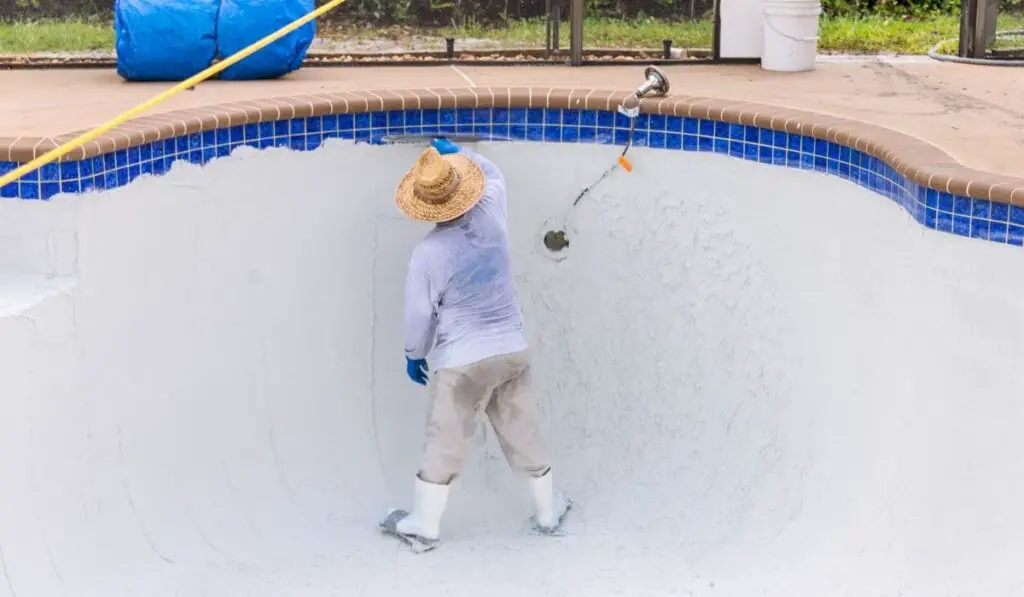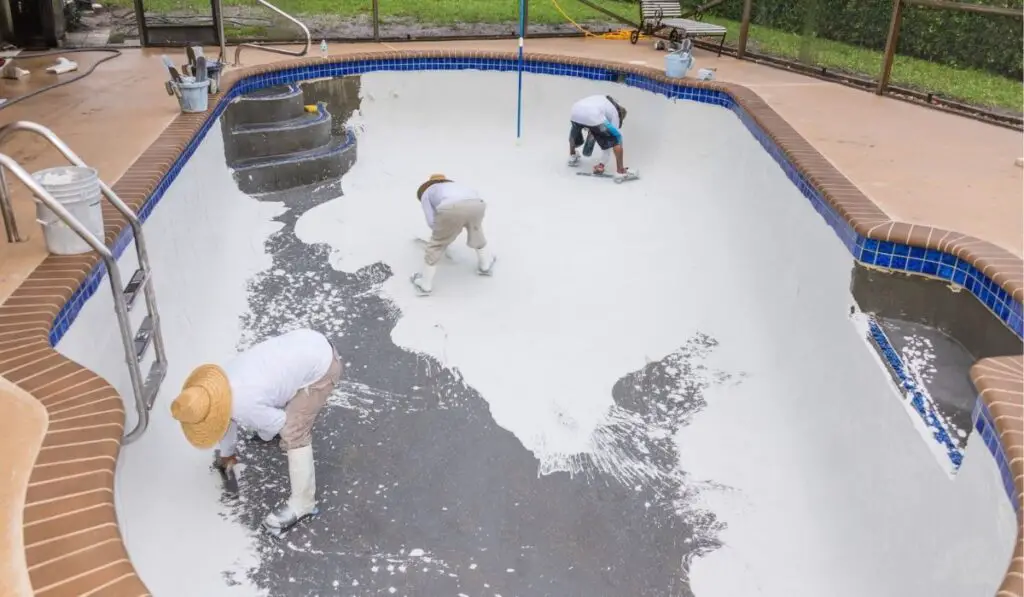Gunite pools are built with a rebar framework coated with a mixture of sand, concrete, and water. The material is highly resistant. But as time passes, gunite pools may begin to show signs of cracks, stains, discoloration, or uneven, rough surfaces that can eventually result in leakage. So, can gunite pools be repaired?
Pool owners can make basic repairs to a gunite pool, such as fixing superficial cracks in the pool’s plaster. However, structural cracks should be addressed by a professional in order to prevent serious leakage from occurring. Gunite pools can be repaired in general, even large cracks.
Let’s look at some of the common problems with gunite pools and how to fix them. This is one of the most durable styles of pools, but only if you know how to maintain it!
Common Issues With Gunite Pools

Every swimming pool has its unique advantages and some disadvantages. Gunite pools are no exception. Here are some of the common problems with gunite pools:
Cracks and Leaks
Any kind of pool can crack; however, some pools tend to crack more than others. A majority of concrete pools will ultimately crack over time. That said, there are certain factors that can increase the chances of a pool cracking, even when it’s brand new.
If your gunite pool happens to crack often, it may be a result of inferior design or poor installation. If you experience more than 1 big crack, you’re sort of beyond the scope of this article and need to contact a professional. But it’s not unusual for some small cracks to form as things settle and the ground shifts over time. Dogs jumping in and clawing up the sides may also lead to some crack-like abrasions you don’t like!
Coarse Pool Surface
Gunite pools have rougher surfaces than fiberglass and vinyl pools, but not by a lot. A concrete pool, with its coarse pool surface, still provides a good balance between comfort and resistance.
If your concrete pool is so rough that you get a nasty scratch even when your knee just grazes the surface while swimming, then your pool is probably too rough. If you choose to paint the gunite pool, using an epoxy-based paint will add a few millimeters of coverage over the rough surface, which you may want.
Plaster Peeling
Plaster is among the most popular gunite pool finishes. As is the case with cracks, peeling problems are usually caused by improper plastering techniques at the installation stage.
Spalling is best prevented by hiring a skilled and seasoned installation contractor.
Discoloration
The porous nature of concrete means it absorbs stains easily. Discoloration is not a serious issue for concrete pools; however, it is a challenge that causes frustration among many pool owners. The discoloration is often caused by imbalanced water chemistry.
Therefore, testing the pH of your pool and maintaining proper pool chemistry can prevent discoloration.
How to Repair Cracks in a Gunite Pool
If you’re looking to make basic repairs to your gunite pool, here are some key steps to follow:
- Clean the Pool: Make sure that the pool is totally dry and sweep away any loose dirt from the cracked area.
- Use a Grinder: Deepen and widen the crack using the diamond blade of a grinder. Do this by setting the grinder on low mode and placing it in the crack. Carefully move the grinder around until the crack is larger by a few inches.
Clean the gunite dust with a rag. Use the hose to wet the spot. This way, the gunite will not extract moisture from the cement. - Mix the Cement: Mix two parts white sand with three parts cement in a bucket. If you want, you can also include an acrylic cement bonding agent (on Amazon). Slowly pour one part of water until you have a pasty mixture that doesn’t drip, like peanut butter.
- Caulking: Use the putty knife to apply the mixture to the walls of the crack. You can also take a bead of caulk and apply it across the crack while allowing space for the cement to cover the caulk. Allow about ¼ inch. Let the caulk dry. Then, fill the entire crack with the sand, water, and cement mixture. Remove any excess and use a trowel to smoothen the top.
- Plastering: Once dry, coat the remaining plaster over the surface.
How to Resurface a Gunite Pool

- With the use of a storm drain, drain the water out of the pool.
- Before the refinishing, carefully clean and chemically etch the surface of your gunite swimming pool.
- Dissolve stubborn grease and oil using mild trisodium phosphate (TSP) solution (on Amazon), while smooth surfaces can be cleaned and etched using a diluted muriatic acid solution.
- After acid washing, use a sodium bicarbonate solution.
- Sand smooth repaired spots to prevent them from showing through the repaired coating.
Tips for Maintaining a Gunite Pool
You can prevent many problems with your gunite pool through proper maintenance. Below are some tips to guide you in maintaining your pool:
- Take out the debris from your pool frequently.
- Check the filter and remove any debris.
- Keep the pH and chemical composition of your pool balanced. Use a simple chemical test kit like the Poolmaster 22260 Essential Collection Chemistry Set (on Amazon).
- Keep a plaster repair kit like this one (on Amazon) on hand to deal with pesky cracks or scratches as soon as you notice them.
- Let your pump run every day.
- Your pool should be acid washed when the water turns murky from algae growth.
Most pools require acid washing at least every 5-7 years, so remember that when you’re thinking about acid-washing your pool. To determine when it’s time to acid wash your pool, look for water that appears murky and blackish or greenish.
